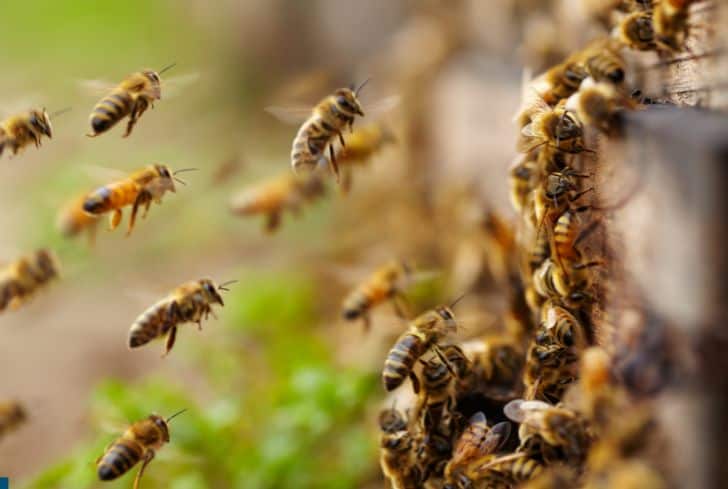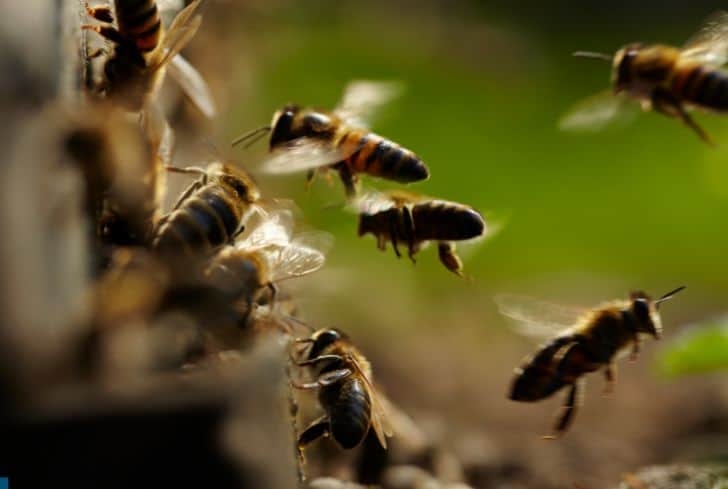How High Can Bees Fly? (And Can They Fly in the Rain?)

Bees are winged insects known for their important role in pollination and the production of honey. There are over 16,000 known species of bees, some of which (like honey bees and bumblebees) live socially in colonies, while most are solitary.
Almost all of us have had encounters with bees, often not very pleasant. But have you ever wondered how high bees can fly? In this article, we will begin by looking at the flying mechanism of bees. Then we will discuss an experiment conducted to see how high bees can fly. Finally, we will talk about the other conditions that impact the flight of bees.
Read: How Far Can Mosquitoes Fly?
How High do Bees Fly?
Bees generally don’t need to fly more than a few hundred feet above the ground. This is because most of their food (nectar and pollen) is on the ground. However, scientists have found that bees are capable of flying as high as 9000 m (30,000 feet), which is higher than the height of the peak of Mount Everest (8,849m).
The biggest constraint for bees when it comes to flying is temperature. The inside of a bee needs to be very hot. Usually, it’s around 50°C because the bee uses a lot of energy and the chemical reactions happen very quickly.
When the temperature is too low, these reactions don’t happen quickly enough. The bees are unable to flap their wings fast enough and fall. So, it’s the temperature, not so much the altitude, which can affect the flight of bees.
Can Bees Fly in the Rain?
Bees can fly in the rain, but they generally do not. They use sunlight for navigation, and clouds make this difficult. Rain also makes their wings wet, slowing down their flight. In some cases, if it’s pouring hard, the rain can even break the bee’s wing.
Most bees can fly with some water drops on their wings, but when the moisture begins to build up, it can add a lot of extra weight to flying. This slows them down and can even make them unable to fly altogether.
Yet sometimes bees do fly during the rain. Check out this video of bees flying in and out of their hive during a rainstorm.
Can Bees Fly Higher Than Mount Everest?
Yes. While bees generally don’t need to fly higher than a few hundred feet above the ground, they can fly at altitudes over 9000m—higher than that of Mount Everest. However, bees cannot survive the extremely cold conditions of these mountains, so scientists have only tested their flight capacity in laboratory experiments.
Michael E. Dillon and Robert Dudley experimented with testing the flight performance of alpine bumble bees. Their team traveled to Western China and collected six male bumblebees of the Bombus impetuosus species. This is an alpine species that live at about 3000m (10,660 feet) altitude, but they are not very different from the species that live closer to sea level.
The scientists placed these bees in transparent, sealed boxes. Then, using a hand pump, they adjusted the oxygen levels and air density while keeping the temperature constant. In this way, this simulated the conditions of high altitude without the freezing conditions.
Through advanced video cameras, they recorded how bees adjusted to the thinner air and lower oxygen concentrations that are found in higher altitudes. They discovered that bees modulated their stroke amplitude rather than their wingbeat frequency to fly in these conditions.
In other words, the bees did not beat their wings faster; instead, they increased the angle at which they stretched their wings with each beat. This helped them increase the amount of air they pushed, allowing them to lift their bodies.
Can Bees Fly Straight up?
Yes, bees can fly up, down, forward, and backward. They can even hover at one place in the air. A bee’s wings are attached to its thorax, the middle part of its body. When the bee moves its thorax up and down, the wings also move. Bees beat their wings over 200 times per second to fly.
But their wings don’t exactly flap up and down, as we might imagine. They twist in a special pattern. When bees beat their wings so rapidly, they spin the air around them, creating a kind of mini-tornado. And it’s by this movement of air around them that they can fly in any direction.
Bees use another unique method of flying. Unlike birds, they on what is known as the resonance frequency. One initial movement starts with very fast vibrations, and bees then don’t need to send a signal for every single wing movement.
They send a signal once in a while, and it keeps the muscles vibrating. Flies, beetles, and even hummingbirds use this technique of vibration to fly.

Why Can Bees Fly High?
Bees fly with wings that make short, sweeping motions front and back. Their wings are flexible, which twist and rotate to enable flying. Bees, like several insects, exhibit what’s known as indirect flight. That is, while flying, they conserve energy by flexing other muscles inside their body.
Bees press their thorax in certain ways to move their muscles and wings. This allows them not only to get the flying motion but also helps them swing their wings at different angles, thereby adjusting speed or direction.
This movement of the wing also allows them to create a vortex or mini-tornado underneath their wings, which lifts them in the air. Check out this beautifully animated video by Smithsonian National Air and Space Museum.
Moreover, as we discussed above, bees can change their stroke amplitude, which allows them to fly even in conditions (low oxygen and low air density) of higher altitudes. That is, they increase the angle at which they beat their wings, stretching them further to the head and abdomen with each beat.
How High Can Bees Survive?
Alpine bees can fly as high as 9000m (30,000 feet), which is greater than the height of Mount Everest. However, this is only true if the temperature is controlled, as in an experiment—bees cannot survive the harsh cold of upper altitudes. Still, they exhibit an impressive ability to modulate their stroke amplitude.
By changing their stroke amplitude, that is, increasing the angle at which they beat their wings, bees can fly even in low oxygen and low air density—conditions similar to those in upper altitudes.
Based on this, the scientists concluded that bees are not necessarily limited by flying capacity in search of colonies. Instead, the availability of food is what mostly determines how high they fly. Since nectar and pollen, their main food sources, are available on land, they rarely need to fly high.
More importantly, this could prove very helpful for bees in the future. Climate change, or the increasing temperatures in lower altitudes, might force animals and insects to go higher up. In such cases, the ability of alpine bees to adjust their flying technique could be a lifesaver.
Finally, this study can also help our aeronautical projects. Currently, helicopters struggle to fly in low air density conditions, such as in rescue operations on mountains. By studying the flying mechanism of bees, perhaps we might something that could help our flights too.
Do Bees Have the Ability to Cross Oceans?
No. Bees cannot fly across oceans. Their average flying speed is about 15-20 mph. The distance between Europe and America is around 5000 miles. It would take a bee 10 days of non-stop flying to cover that distance, and it’s unlikely to survive such a journey.
Bees don’t need to fly across large distances. They can fly as far as 8 miles but usually don’t go beyond 2 miles to acquire food. Most of the foraging bees don’t go beyond half a mile, and young bees stay within a few hundred meters of the hive.
Can Bees Fly as High as Birds?
Bees can fly at altitudes of over 9000m (30,000 feet), higher than that of Mount Everest. However, they cannot survive in the extreme cold of such altitudes, so their flying ability has only been tested in the laboratory. On the other hand, birds can fly and survive at incredible altitudes in the real world.
The highest flying record is held by a Rüppell’s vulture, which flew into a jet engine flying at 37,900 feet above West Africa. The plane managed to land safely, despite the damage. The bar-headed goose regularly flies directly over the Himalayas while travelling from Tibet to India, sometimes going directly over Mount Everest.
At What Temperature do Bees Stop Flying?
The minimum temperature required for bees to fly is about 54°F, and the optimal temperature for flying is between 70-80°F. However, they cannot fly when the temperature is below 54°F. This is because the temperature inside their bodies needs to be high enough to facilitate chemical reactions and flying.
The inside of a bee reaches over 122°F because it uses a lot of energy and chemical reactions take place very quickly. If the temperature is too low, these reactions don’t happen quickly enough. Then the bee is not able to flap its wing fast enough and therefore cannot fly.
Conclusion
In this article, we have looked at how high bees can fly. In the study conducted by Dillon and Dudley, it was found that bees can fly at altitudes as high as that of Mount Everest, and they do this by modulating their stroke amplitude. However, they cannot survive extreme cold. In most cases, bees do not have to fly too high or too far because their food is easily available on land.

